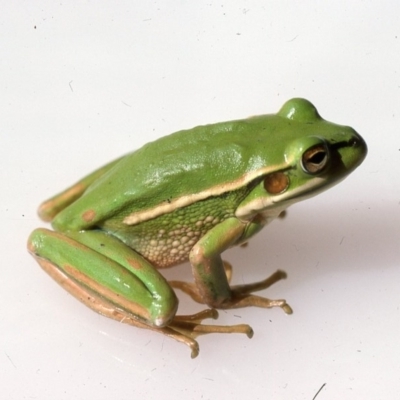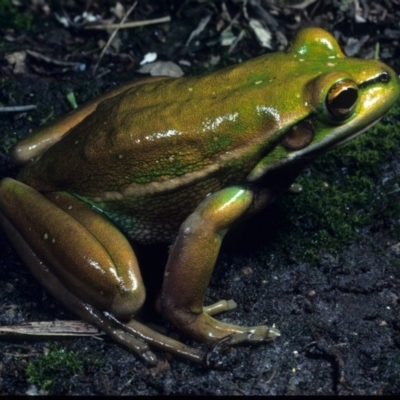Litoria aurea (Green and Golden Bell Frog)
Green and Golden Bell frogs are forocios predators, capturing invertebrates and small frogs, including their own species.
Current conservation status: Extinct in ACT (Vulnerable), Endangered (NSW), Nationally vulnerable.
Family: Hylidae
Appearance: A large green or green and brown/gold cloured frog, with fully webbed toes. They have a smooth back and bright blue or purple on the hind side of the thighs.
Length: up to 120mm
Breeding: Calls from September to January. During spring and early summer, following heavy rains, the frogs lay large, gelatinous egg masses that are usually spread as a surface layer through vegetation. Because of their large clutch size (typically many thousands of eggs) the egg mass spreads to occupy a large area (larger than a dinner plate), forming a transparent, floating jelly-like layer that later sinks.
Habitat: Found in low-land rivers, swamps, farm dams and lakes. This species is semi-aquatic, spending much time in wetlands, either perched amongst emergent vegetation, or simply floating or swimming in the water. It is well known for its habit of basking in direct sunlight. Prior to their decline, the bell frog group were found in ponds, swamps, lakes and along slow-moving parts of some rivers, such as the Molonglo. Sites that supported the species were typically thickly vegetated with reeds, sedges and rushes and contained relatively permanent water that did not contain predatory fish. Most sites were in open country, but the frogs have also been recorded in some forested areas.
Distribution: Predominantly coastal species with the western-most occurence being near Canberra. The species has disappeared almost entirely from its former range in the Southern Tablelands.
Call: A relatively quiet, but distinctive drawn out "wrrraaaaagh..wrrraaaaagh.. wrrrrkk, wrrrrkk, wrrrrkk" sometimes likened to a motorbike changing gears.
Litoria aurea is listed in the following regions:
Canberra & Southern Tablelands | South Coast
Species information
- Litoria aurea Scientific name
- Green and Golden Bell Frog Common name
- Sensitive
- Endangered *
- Non-invasive or negligible
- Machine learning
- External link More information








